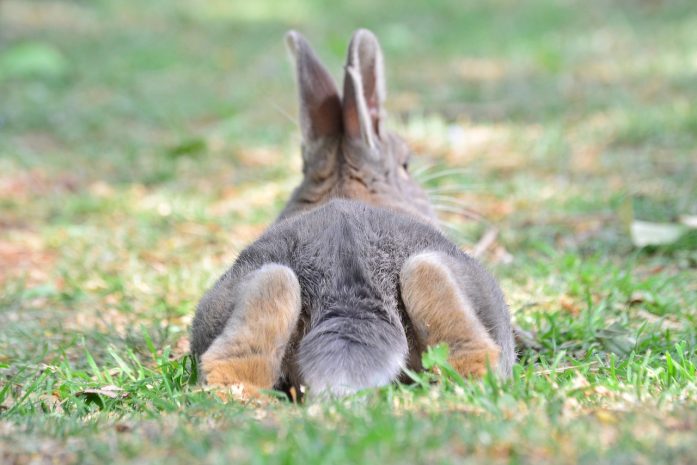
Can rabbits get flystrike? Should you be worried about flystrike in your rabbits? What should you do if your rabbits do get it?
A little-known fact is that rabbits can in fact get flystrike. Flystrike, which is known more to farmers, is an infestation of sorts when fly eggs are laid and hatched in a rabbit’s fur. While it may be uncomfortable to face, it’s important to prevent or treat because if ignored, it can result in infection and even death.
Like many things, prevention is the key because treatment is much more difficult. Keep reading to learn about flystrike in rabbits, how you can prevent it, and what to do if your rabbit has a flystrike.

Also known as myiasis, flystrike is when flies lay eggs in your rabbit’s fur. Then, the eggs hatch into maggots that burrow into your rabbit’s skin to grow and eat the surrounding tissue.
Blowfly strike was identified in 243 of 42,226 rabbit consultations (0.6%), affecting 205 individual rabbits. The anatomical site of recorded blowfly strike lesions was overwhelmingly the perineal area (n = 109, 52.4%). Less commonly lesions were observed affecting other areas of the body (n = 9, 4.3%) and head (n = 8, 3.8%); in 83 consultations (39.9%), the affected area was not specified. Of the rabbits presenting with blowfly strike, 44.7% were recorded as being euthanized or died.
https://www.ncbi.nlm.nih.gov/pmc/articles/PMC5910172/
There are different types of maggots (fly larvae), with botflies, blue bottle flies, and green-bottle flies being the most common culprits of flystrike in rabbits. However, botflies are the most dangerous. These maggots burrow deep inside of the skin and grow inside the tissue of your rabbits, creating open, painful sores.
Not only is flystrike in rabbits just plain gross, but it can also become quite dangerous for your rabbits, who are sensitive to infection. If the maggots do burrow into your rabbit’s skin, it can become fatal within just 24 hours.
This usually happens during the summer when flies are rampant. If they live inside of a dirty enclosure, have open wounds, or a buildup of urine or feces in their fur. It can also happen if you leave fruits or veggies on the ground, and your rabbit steps all over them, and it’s caught up in their feet or bottom.
This attracts flies, which come, feast on whatever’s there, and lay hundreds of eggs, depending on the type of fly. As mentioned, this can become quite dangerous once the maggots burrow into your rabbit’s skin or inside of a wound.
While rabbits that go outside or live outside are much more likely to be affected, finding flystrike in rabbits that live indoors isn’t impossible. If flies enter your home, they will most likely breed and lay eggs.
And, the most likely place would be near their food source, which would be your rabbit’s poop. So, if you don’t regularly clean your rabbit cage or groom your rabbit, then it can happen to indoor rabbits.
Symptoms are usually pretty easy to spot with a close inspection. Finding fly eggs or actual maggots in your rabbit’s coat is a sure sign. But aside from that, here are some other signs that your rabbit could be suffering from flystrike:
Start by clipping the fur that is covered in feces and urine. Then inspect the area. If there are eggs present, but no maggots or open sores, you can pick them out with a fine-tooth comb and wash the area with a wet rag and baby shampoo. Botfly eggs may be more difficult to remove, so you may need to just cut them out.
If any maggots, especially botfly larvae, are present or have burrowed into the skin, your rabbit will have to be taken to the vet straight away because, again, it only takes 24 hours to become deadly. More often or not, there is more than one, and your rabbit will need to be properly sedated, so the vets can get them all out and clean the wound.
In severe cases of flystrike in rabbits, surgery is required. Following the vet visit, you may also need to give antibiotics to your rabbit.
Flystrike prevention is absolutely necessary because of how fast it turns fatal. In reality, it can go completely unmissed, if you’re not careful. So, to help you keep your bunny safe from flystrike, here are some ways you can prevent it.
Make sure to check your rabbits daily for any signs of flystrike. If your rabbit has any wounds, take care of them immediately. Daily grooming is a great time for you to give your rabbit a closer look while bonding at the same time.
Vaseline can be used on top of any treatment as a means to keep flies away. Because of the consistency, flies can land on it. So, they definitely won’t be tempted to lay their eggs there.
When you spot a bit of poop or urine buildup, wash it with a wet rag and some baby shampoo and dry. Also, trim your long-haired rabbits, like Angora or Lionhead breeds. If the hair is dragging on the ground and susceptible to picking up urine and feces.
Remember to discard poop and wet shavings often and replace them with lots of fresh bedding. If your rabbits have an outdoor enclosure on the ground, move the enclosure or rake it if you can.
Feed your rabbit lots of fiber. Leafy greens and an endless amount of hay are sure to keep your rabbit’s poop healthy, so it doesn’t build up down there.

Your rabbit should be seeing a vet at least once every year for a check-up and whenever they’re acting irregularly. Additionally, be sure to keep an eye on your rabbit’s teeth. Sometimes, when a rabbit’s teeth have overgrown, a rabbit isn’t able to groom properly.
When it comes to flystrike in rabbits, prevention is key. As you’ve learned, not can it turn deadly very quickly, but also means a high vet bill and danger for your precious pet rabbit. Prevention is much better than treatment.
As long as your rabbits are clean and healthy, you really shouldn’t have to worry about them. Check them regularly for any eggs. And, if you do find your rabbit has flystrike, take them to a vet immediately to be properly treated.

By entering your email address you agree to receive emails from Cottontailclub. We'll respect your privacy and you can unsubscribe at any time.